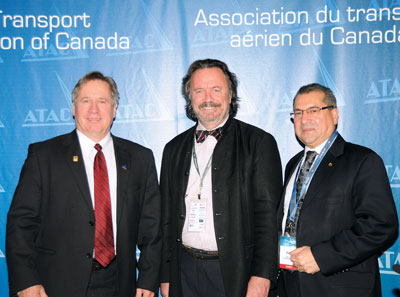
Features
Regulations
Safety
Glide Path: Increased need for accountability
The Air Transport Association of Canada (ATAC) AGM in Vancouver last Nov. 13-15 was built on the theme, “The Need for a New National Aviation Policy”
January 4, 2013 By Paul Dixon
The Air Transport Association of Canada (ATAC) AGM in Vancouver last Nov. 13-15 was built on the theme, “The Need for a New National Aviation Policy” and the key speakers were definitely on message, from the opening address by ATAC president/CEO John McKenna, to the morning plenary featuring Sen. Denis Dawson and CEO of Intervista Consulting Gerry Bruno, to the luncheon presentation by Tony Gugliotto, senior VP of marketing/business development with YVR.
 |
|
| Things will be status quo until the federal government sees the aviation sector as an economic driver rather than a source of revenue. PHOTO: Paul Dixon
|
Dawson (above centre), chair of the Standing Senate Committee on Transportation and Communications, was quite blunt in calling out the government for failing to take a leadership position in policy development. He gave a brief history lesson in outlining the changes that have occurred in Ottawa since he first arrived as a young member of Parliament in the mid-’70s. There was no national transportation policy or aviation policy at the time and the government owned all the airports under the stewardship of Transport Canada. Subsequently, individual MPs would make their pitch to the minister of transport for improvements to airports within their constituencies.
In the early ’90s the regionalization, privatization and semi-privatization of airports changed the dynamic. Decisions regarding expenses were all of a sudden being made locally, but the money was still flowing to Ottawa. Then 9/11 happened and security became a big deal. In the United States, where the attacks took place, the federal government took responsibility for the new levels of security, whereas in Canada, the expense was directly downloaded on to the operators and their customers. The result? More than a billion dollars has been taken out of the industry in taxes and fees. In Dawson’s view, the American government assumes responsibility for many of the costs associated with airports and aviation because it wants to encourage people to travel by air; in Canada, we seem to be putting obstacles all over the place.
McKenna (above left) lamented in his opening remarks that unless the minister of transport is willing to champion the industry, there won’t be a level of awareness at the cabinet level or higher. Dawson agreed and was blunt in saying that in recent years, the power in cabinet lay with the Minister of Finance and the transport portfolio didn’t carry much clout. And things will be status quo until the federal government sees the aviation sector as an economic driver rather than simply a source of revenue.
Bruno spoke to the changes that have taken place over the past 20 years and with a wistful tone about what might have been. He characterized the Canadian aviation business as having moved out of the Dark Ages, but said it has yet to reach the Renaissance. He maintains that the federal government has been dragging its feet on too many issues that other governments have moved ahead on, for example, expanded open skies with the U.S. and open skies with the European Union.
Many external factors have had an impact on the aviation industry in recent years, from 9/11 and skyrocketing fuel prices to the world economic meltdown. Other factors have added to the challenges faced by airports such as YVR as Gugliotto outlined.
Conceived as a gateway airport, YVR was known as Canada’s connection to the Orient, but that changed starting in 2000 as Russia opened its airspace to airlines flying the polar routes between Asia and North America. This development, coupled with the emergence of extended-range airliners, has made cities such as Toronto, New York, Chicago and even Dallas became gateway cities for direct flights from Asia. Between 2000 and 2010, YVR saw no growth on the Asia routes. What YVR has done in the past two years is concentrate on attracting new Chinese airlines serving cities outside of Beijing and Shanghai. Today, YVR serves the most Chinese airlines of any North American airport (six), with a total of 63 weekly flights.
Canada’s “lost airport,” the five million Canadians who choose to cross the border and fly out of American airports to take advantage of cheaper fares, was touched on by all speakers. Gugliotto pointed out that when the operating costs for airlines are so high at Canadian airports, it’s not just a matter of Canadians crossing the border; it’s also a matter of other airlines deciding that all things being equal, it’s not in their best financial interests to fly into Canada, so they take their business elsewhere.
In the end, there are many challenges facing the industry today, and through ATAC, operators are trying to meet these challenges and be competitive in a world market that changes daily. There may not be a silver bullet, but a change of attitude on the part of the federal government and a demonstrated willingness to embrace the issues in something more than a sound bite or press release is urgently needed.
Paul Dixon is freelance writer and photojournalist living in Vancouver.